
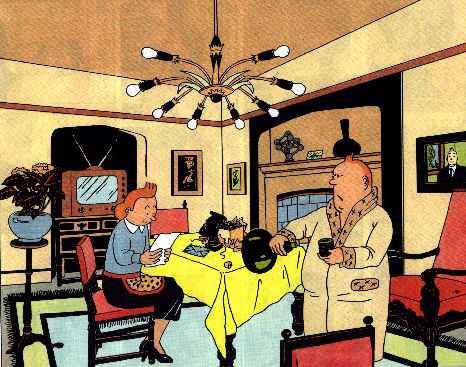
Like any "classic" worthy of this name, Hergé's works didn't escaped the world of plagiarism, imitations and parodies of any kind. In fact, those are so numerous that it would be difficult to index them entirely. However, in most of the cases, they only have one quality: they show us how the originals are great...
Pirate books
When we discuss the pirate editions of Tintin's adventures, we cannot overlook the case of Tintin in the Land of the Soviets. The first 500 numbered specimens and the nine other editions which followed are objects as rare as coveted. It was the only pre-war book Hergé did not redraw in color, undoubtedly preferring to leave this first awkward creation aside. However, as Tintin's popularity kept growing, the book became a legend and extremely scarce. For the fortieth anniversary of the series, in 1969, there was an non-cemmercial republication of 500 numbered specimens, which only accentuated the myth surrounding the album. In the Seventies, the keen demand sustained a wave of pirate editions of doubtful quality and prohibitive price. Hergé initially actionned the pirate publishers but, seeing that the phenomenon kept increasing, he agreed to publish Tintin in the Land of the Soviets in Archives Hergé to cut the ground from under the forgers' feet. Far from disappearing, new pirate editions reappeared, of much better quality and imitated carefully. Finally, to put an end to this market, Casterman published a facsimile in any point similar to the original in 1981, a successful initiative.
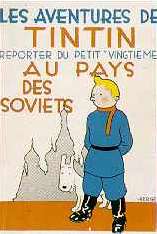 | 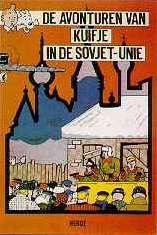 |
| Covers of two pirate editions | |
In addition to Tintin in the Land of the Soviets, several other books were victims of pirate editions: large size editions of Prisoners of the Sun with pages drawn from the Tintin magazine, The Shipwreck of the Unicorn, which used the strips published in Le Soir during the war, inset plates from the black and white versions, annotated pages from The Blue Lotus etc. A Turkish editor did even publish twenty-two small books more or less inspired by the originals, sometimes plunging Tintin in strange adventures...
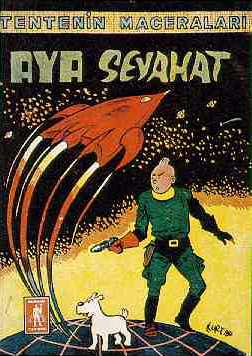
Cover a Turkish pirate edition
Imitations and parodies
Definitely, Ramo Nash's friends give Tintin a rough time. We can hardly count all the imitations of Hergé's work, with or without claim, sometimes with bad taste. Yet in the Thirties, Le Petit Vingtième invited the young readers to publish their drawings "after the manner of Hergé". However, a totally different affront was awaiting Tintin after the war: the newspaper La Patrie published strips under an evocative title: The Adventures of Tintin and Milou in the Land of the Nazis... In 1972, the Internationale Situationniste created parodies by preserving the original drawings and modifying the texts, which gave us The Capital with the Golden Claws and The Road of the Sun...
In addition, several cartoonists carried out their own adaptation of Hergé's drawings, such as Cabu, Moebius and Wolinski, which drew the three pages of Tintin for the Ladies... We cannot forget the famous Tintin in Switzerland (see the illustration under the title), a parodic album more or less successful, prohibited in Belgium and France after a lawsuit for plagiarism, but authorized in Holland, where it generated its own imitations... More recently, since the publication of Tintin and the Alph-Art, several artists tried to finish the ultimate adventure of Tintin, something that the Hergé Foundation didn't really appreciate...

A strip from Tientien en Bordélie, by Roger Brunel
Objectif Monde
A big surprise was in store for the tintinophile readers of Le Monde on January 28, 1999. To celebrate Tintin's 70th "anniversary" and the Comics Festival in Angoulême, the Parisian newspaper published a pastiche by David Savard entitled Objectif Monde (Destination World).
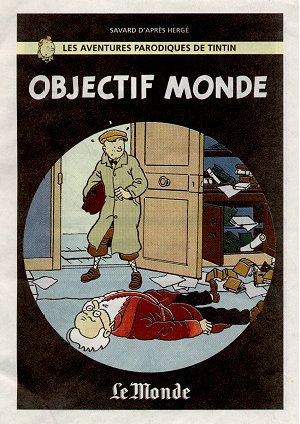
Cover of Objectif Monde
The big surprise was that the Hergé Foundation gave its authorization and allowed the publication of this first "official" pastiche, fully approved by Hergé's beneficiaries. The short story, 26 pages long, tells the adventures of Le Monde's reporter Wzkxy, nicknamed Tintin because of his passion for the character, with multiple allusions to the adventures of Tintin. In short, Savard succeeded in creating a very nice tribute to Hergé as well as a new collectors' item...
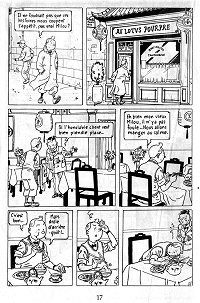
A page of Objectif Monde
In Quebec...
Here in Quebec like elsewhere, Tintin's world is regularly the subject of pastiches and imitations. Here is a short selection...
- Pauline Marois as the Castafiore - A caricature of Serge Chapleau...
- Jean-François Lisée as Tintin - Another caricature of Chapleau...
- Les Aventures de Boubou - Various albums re-examined and corrected by Antoine, for Le Devoir (1992)...
- Les copains d'abord - an illustration from the magazine Hommes (summer 1986)...
- Croc spécial gai - The cover of the humoristic magazine Croc (1983)...
- Le monde de la télé - A short comic strip of Malouin which associates Tintin and Brad Pitt (!) in the last TV Hebdo of 1996...
- Congo... l'horreur! - A caricature of André-Philippe Côté in Le Soleil of Quebec City, August 31, 1998...
- La théorie des fédéralistes agonisants - A caricature of Chapleau in La Presse of Montreal, August 24, 1999...
- Paul Martin and Bernard Landry as Thompson and Thomson - A caricature in Le Nouvelliste of Trois-Rivières, May 16, 2000...
Actually, Tintin is such a cultural reference, here as well as in France or Belgium, that we can find references to him everywhere. For example, this poster celebrating the victory of the students of the Université du Québec à Montréal against the exclusivity contract the administration had negociated with Coca-Cola... (The Red Sea Sharks original title in French is Coke en stock.)
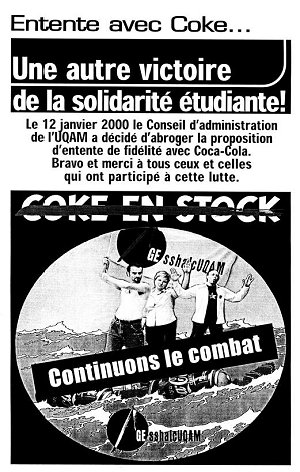
We could debate for a long time the quality of all these parodies and imitations and their contribution to the universe of Tintin. And the discussion is still going on among tintinologists' circles. Let's give the conclusion to Hergé: talking about the possibility that another artist could continue Tintin's adventures, he said that maybe it would be better, maybe it would be worse, but it surely wouldn't be his Tintin...


